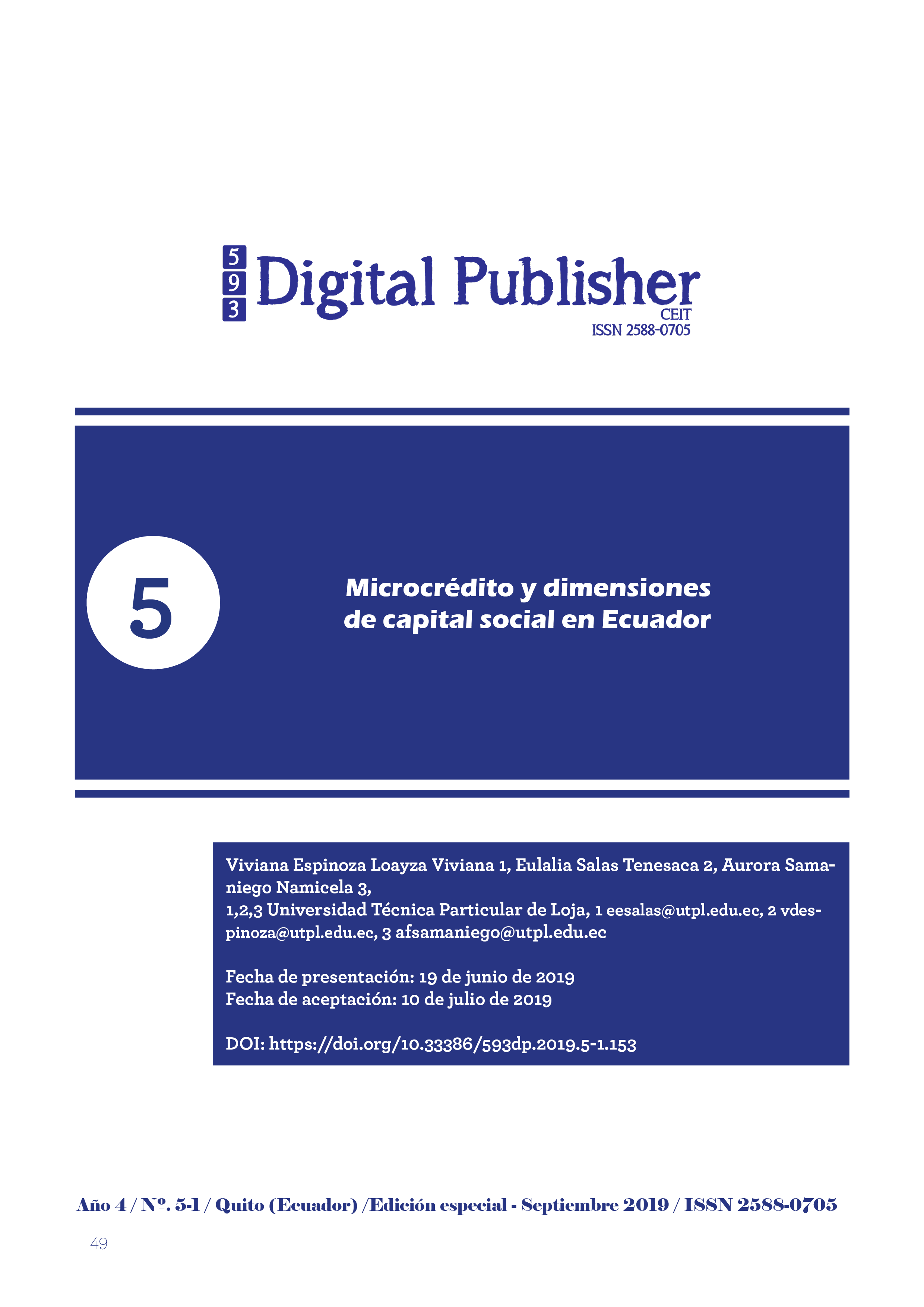Microcredit and social capital dimensions in Ecuador
Main Article Content
Abstract
The aim of the work is to establish the relationship between microcredit and the generation of social capital dimensions in the province of Loja, Ecuador. A descriptive exploratory study was carried out, and a survey was applied to 3989 micro-entrepreneurs. Among the main results, it is appreciated that de 30% if micro-entrepreneurs maintain a bonding capital, and microcredit has allowed strengthening this type of union relations and in a smaller percentage the relationships with others.
Downloads
Article Details
1. Derechos de autor
Las obras que se publican en 593 Digital Publisher CEIT están sujetas a los siguientes términos:
1.1. 593 Digital Publisher CEIT, conserva los derechos patrimoniales (copyright) de las obras publicadas, favorece y permite la reutilización de las mismas bajo la licencia Licencia Creative Commons 4.0 de Reconocimiento-NoComercial-CompartirIgual 4.0, por lo cual se pueden copiar, usar, difundir, transmitir y exponer públicamente, siempre que:
1.1.a. Se cite la autoría y fuente original de su publicación (revista, editorial, URL).
1.1.b. No se usen para fines comerciales u onerosos.
1.1.c. Se mencione la existencia y especificaciones de esta licencia de uso.
References
Alesina, A. y E.LA Ferrara (2002). Who trusts others? Journal of Public Economics, 85, págs. 207-234.
Atria, S. M. (2003). Capital social y reduccion de la pobreza en America latina y el Caribe. Chile: CEPAL.
Bourdieu, P. (1980). El capital social. Notas provisoires. Acta de investigación en Ciencias Sociales, 2-3.
Bordieu, P. (1980). Le capital social. Notes provisories. Actes de la Recherche en Sciences Sociales, 3.
Capdevielle, J. (2013). Capital social: debates y reflexiones en torno a un concepto polémico. Revista de Sociología e Politica, 3-14.
Coleman, J. (1988). Social capital and the creation of human capital. American Journal of Sociology, 94, págs. 95-120.
Coleman , J. (1990). Foundations of Social Theory. Cambridge: Harvard University.
Coleman, J. (1987). Norms as Social Capital. Economic Imperialism. The economic method applied outside the field of economic. New York: Paragon House Publishers.
Coleman, J. (1988). Social Capital in the Creation of Human Capital. American Journal of Sociology, 95-121.
Cordova, E. J. (2003). Una alternativa para el desarrollo.
Durston, J. (2001). El capital social en seis comunidades campesinas de Chile: adelantos y desafios de una investigación en marcha. CEPAL, 39- 51.
Durston, J., & Miranda, F. (2001). Capital social y políticas públicas en Chile. Santiago de Chile: CEPAL.
Espinoza, V. (2001). Indicadores y generación de datos para un estudio comparativo de capital social y trayectorias laborales. Santiago de Chile: CEPAL.
Gutiérrez, A. (2004). La teoría de Bourdieu en la explicación y comprensión del fenómeno de la pobreza urbana . Madrid: Fundamentos.
Gutiérrez, A. (2005). Acerca de la noción del capital social como herramienta de análisis. Reflexiones teóricas en torno a cun caso empírico. Perspectivas, 7-26.
Gutiérrez, A. (2005). Pobre como siempre. Estrategias de reproducción social en la pobreza. Córdoba: Ferreyra.
Gutiérrez, A. (2008). El capital social en la pobreza: apuesta, medio y resultado de luchas simbólicas. Córdoba : Universitaria Villa María.
Iannatale, S. O. D. I. G., Lbittar, a L. E., Aya, L. U. C. Y. N. M., & Lfredo, a. (2010). Confianza , redes sociales y hábitos financieros : Un estudio empírico.
Knack, S. y P. Keefer (1996). Does social capital have an economic payoff?. Quarterly Journal of Economics, 112 (4), págs. 1251-1288.
Pérez, F., & Fernández, J. (2006). Banca relacional y capital social en España. Competencia y confianza. España: BBVA.
Putnam, R. (1993). Making Democracy Work. New Jersey: Princenton University Press.
Putnam, R. (1995). Tunnin OIn, Tunning Out: The strange disappearance of social capital in America. Political Science and Politics, 664-683.
Putman, R. (1995). Bowling alone: America is declining social capital. Journal of Democracy, 6, págs. 65-78.
Putnam, R. (1996). Unsolved mysteries: The Tocquville files: Robert Putnam responds. The American Prospect, Vol 7, 42-60.
Ramírez Plascencia, J. (2005). Tres visiones sobre capital social: Bordieu, Coleman y Putnam. Política y Sociedad, 21-36.
Saltalamacchia, H. (2015). Capital Social: concepto y método. Aportes a la discusión sobre capital social, 1-37.
Sobel, J. (2002). Can we trust social capital?. Journal of Economic Literature, vol. XL, Marzo, págs. 139-154.
Tello, M. (2016). Consorcio de Investigaciones Económicas "CIES". Obtenido de http://departamento.pucp.edu.pe/ciencias-sociales/files/2012/06/Aspectosteoricoscapitalsocial.pdf.pdf
Urteaga, E. (2013). La teoría del capital social de Robert Putnam: Originalidad y carencias. Redalyc, Refleción Política, 44-60. Obtenido de http://www.redalyc.org/pdf/110/11028415005.pdf
Valdez, M. (2012). Naturaleza y alcance del capital social en las comunidades rurales. Educación y Humanismo, 31-45

